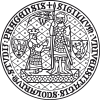 On Thursday 30th September 2021 Marek Tuhý successfully completed his PhD and defended his PhD thesis entitled “Wildfires in polluted areas: mineralogical transformations and remobilization of metal(loid)s“. The thesis was supervised by prof. Vojtěch Ettler and reviewed by Dr. Isabel Campos (University of Aveiro, Portugal) and Dr. Tomáš Navrátil (Institute of Geology, CAS). Marek will continue as a Junior Researcher affiliated with the Center for Geosphere Dynamics. Congratulations!
On Thursday 30th September 2021 Marek Tuhý successfully completed his PhD and defended his PhD thesis entitled “Wildfires in polluted areas: mineralogical transformations and remobilization of metal(loid)s“. The thesis was supervised by prof. Vojtěch Ettler and reviewed by Dr. Isabel Campos (University of Aveiro, Portugal) and Dr. Tomáš Navrátil (Institute of Geology, CAS). Marek will continue as a Junior Researcher affiliated with the Center for Geosphere Dynamics. Congratulations!
Author Archives: ettlerv
Accelerated disintegration of in situ disconnected portions of sandstone outcrops
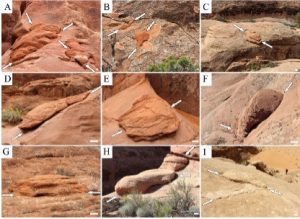 The article presents a new look on sandstone weathering/recession characterized by rapid disintegration of portions of the rock massif which are no longer physically connected with the main rock mass, though still in situ. A set of field and laboratory measurements testing mechanical and hydraulic properties of the rock were applied to compare the disconnected portions with those of the surrounding rock mass. Also, physical weathering experiments were performed to characterize the effect of confinement on the breakdown rate of several sandstone samples. The surfaces of disconnection follow bedding planes, planar elements of other sedimentary structures, subhorizontal fractures and stress shadows on subvertical cliff faces. Weathered surfaces of the disconnected portions show noticeably impaired mechanical properties, a faster capillary water absorption and a higher surface moisture compared to the much less weathered surfaces of the surrounding rock mass. Physical experiments demonstrated that a confinement by the surrounding rock mass may considerably delay the loosening of rock during weathering. The much faster disintegration rates of the disconnected portions of rock compared to their surroundings are explained by the fact that they are not confined and have a larger surface area.The recession rates of sandstone surfaces with disconnected portions are highly variable both in space and time and their genesis is demonstrated by two suggested conceptual models.
The article presents a new look on sandstone weathering/recession characterized by rapid disintegration of portions of the rock massif which are no longer physically connected with the main rock mass, though still in situ. A set of field and laboratory measurements testing mechanical and hydraulic properties of the rock were applied to compare the disconnected portions with those of the surrounding rock mass. Also, physical weathering experiments were performed to characterize the effect of confinement on the breakdown rate of several sandstone samples. The surfaces of disconnection follow bedding planes, planar elements of other sedimentary structures, subhorizontal fractures and stress shadows on subvertical cliff faces. Weathered surfaces of the disconnected portions show noticeably impaired mechanical properties, a faster capillary water absorption and a higher surface moisture compared to the much less weathered surfaces of the surrounding rock mass. Physical experiments demonstrated that a confinement by the surrounding rock mass may considerably delay the loosening of rock during weathering. The much faster disintegration rates of the disconnected portions of rock compared to their surroundings are explained by the fact that they are not confined and have a larger surface area.The recession rates of sandstone surfaces with disconnected portions are highly variable both in space and time and their genesis is demonstrated by two suggested conceptual models.
Filippi M., Slavík M., Bruthans J., Weiss T., Řihošek J. (2021): Accelerated disintegration of in situ disconnected portions of sandstone outcrops. Geomorphology 391, 107897. (DOI)
New book on Metallurgical Slags
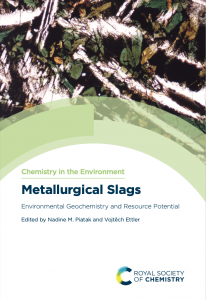 A new book entitled Metallurgical Slags: Environmental Geochemistry and Resource Potential edited by Nadine M. Piatak (USGS) and Vojtěch Ettler has been published by the prestigious publishing house, the Royal Society of Chemistry (link). Vojtech Ettler (co-) authored four of nine chapters in the book: Introduction: Metallurgical Slags – Environmental Liability or Valuable Resource? (DOI), Geochemistry and Mineralogy of Slags (DOI), Slag Leaching Properties and Release of Contaminants (DOI), and Environmental Impact of Slag Particulates (DOI). The support of the Center for Geosphere Dynamics is also acknowledged.
A new book entitled Metallurgical Slags: Environmental Geochemistry and Resource Potential edited by Nadine M. Piatak (USGS) and Vojtěch Ettler has been published by the prestigious publishing house, the Royal Society of Chemistry (link). Vojtech Ettler (co-) authored four of nine chapters in the book: Introduction: Metallurgical Slags – Environmental Liability or Valuable Resource? (DOI), Geochemistry and Mineralogy of Slags (DOI), Slag Leaching Properties and Release of Contaminants (DOI), and Environmental Impact of Slag Particulates (DOI). The support of the Center for Geosphere Dynamics is also acknowledged.
Late Archean analogy to modern accretionary plate margins, an example from Superior Province, Canada
New paper recently published in Precambrian Research examines an illustrative example of a Late Archean granitic pluton emplaced along a major tectonic boundary in the Superior Province, northeastern Québec, Canada. To characterize the syn-magmatic strain patterns, we integrate structural and kinematic analysis with anisotropy of magnetic susceptibility (AMS) and numerical modeling of fabric development in response to strain increments. This dataset allowed us to set-up a general geological model that discusses the significance of pluton fabrics, interfering intrusive and tectonic strains, and finally also on evaluating various scenarios for the Late Archean assembly of the Superior Province.
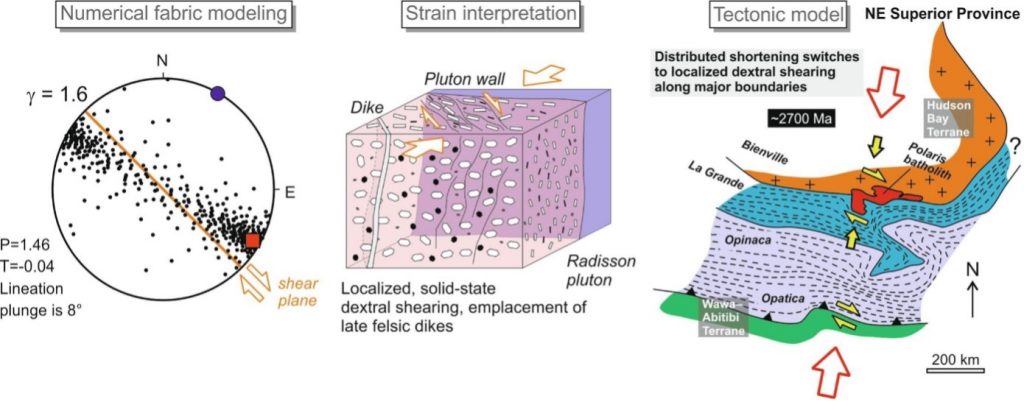
Žák J., Tomek F., Svojtka M., Vacek F., Kachlík V., Ackerman L., Ježek J., Petronis, M.S. (2021): Distributed crustal shortening followed by transpressional shearing in the Superior Province, northeastern Canada: a Late Archean analogy to modern accretionary plate margins? Precambrian Research 362, 106322. (DOI)
Metal(loid)s remobilization from contaminated soils during experimental wildfires
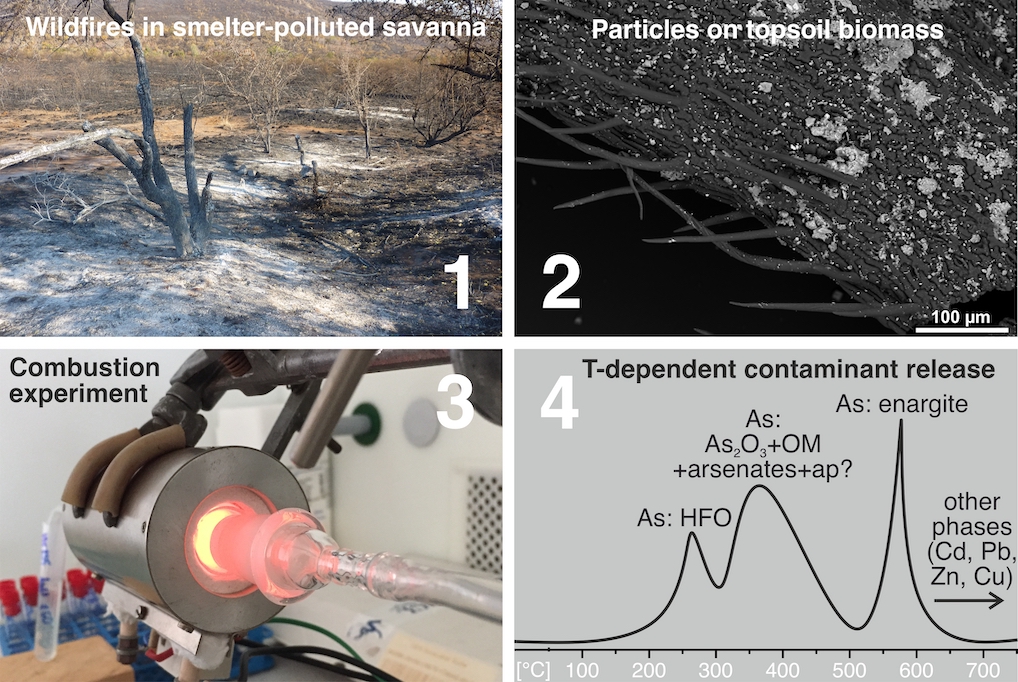 The temperature-dependent releases of metal(loid)s (As, Cd, Cu, Pb, Zn) from biomass-rich savanna soils collected near a Cu smelter in Namibia have been studied under simulated wildfire conditions. For this purpose, new wildfire-simulating setups were introduced. Laboratory single-step combustion experiments (250–850 °C) and experiments with a continuous temperature increase and online ICP-OES detection (25–750 °C) were coupled with mineralogical investigations of the soils, ashes, and aerosols. The results indicate that metals are dominantly concentrating in the ash residue, and part of As is remobilized depending on temperature. Therefore, the active and abandoned mining and smelting sites, especially those highly enriched in As, should be protected against wildfires, which can be responsible for substantial As re-emissions.
The temperature-dependent releases of metal(loid)s (As, Cd, Cu, Pb, Zn) from biomass-rich savanna soils collected near a Cu smelter in Namibia have been studied under simulated wildfire conditions. For this purpose, new wildfire-simulating setups were introduced. Laboratory single-step combustion experiments (250–850 °C) and experiments with a continuous temperature increase and online ICP-OES detection (25–750 °C) were coupled with mineralogical investigations of the soils, ashes, and aerosols. The results indicate that metals are dominantly concentrating in the ash residue, and part of As is remobilized depending on temperature. Therefore, the active and abandoned mining and smelting sites, especially those highly enriched in As, should be protected against wildfires, which can be responsible for substantial As re-emissions.
Tuhý M., Ettler V., Rohovec J., Matoušková Š., Mihaljevič M., Kříbek B., Mapani B. (2021): Metal(loid)s remobilization and mineralogical transformations in smelter-polluted savanna soils under simulated wildfire conditions. Journal of Environmental Management 293, 112899. (DOI)
Looking at a Pb–Zn mining/smelting site in Kabwe (Zambia) using tree rings
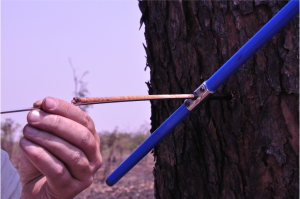 We used pine tree rings and soil geochemistry to expose the activity of a Pb-Zn smelter in Kabwe, Zambia. We found that local soils are extremely contaminated (up to 16000 mg/kg Pb; 14000 mg/kg Zn; 600 mg/kg Cu in the topsoil). Also, metal bearing particles share their Pb isotopic signature with smelting by-products, and more concerning, metals in tree biomass. We concluded that these metals enter the tree though the bark and leaves, not the roots, implying airborne contamination. Using Pb and C isotopes we mapped the dendrochronology of the tree and verified its susceptibility to changes in smelter production throughout the late 20th century.
We used pine tree rings and soil geochemistry to expose the activity of a Pb-Zn smelter in Kabwe, Zambia. We found that local soils are extremely contaminated (up to 16000 mg/kg Pb; 14000 mg/kg Zn; 600 mg/kg Cu in the topsoil). Also, metal bearing particles share their Pb isotopic signature with smelting by-products, and more concerning, metals in tree biomass. We concluded that these metals enter the tree though the bark and leaves, not the roots, implying airborne contamination. Using Pb and C isotopes we mapped the dendrochronology of the tree and verified its susceptibility to changes in smelter production throughout the late 20th century.
Baieta R., Mihaljevič M., Ettler V., Vaněk A., Penížek V., Trubač J., Kříbek B., Ježek J., Svoboda M., Sracek O., Nyambe I. (2021): Depicting the historical pollution in a Pb–Zn mining/smelting site in Kabwe (Zambia) using tree rings. Journal of African Earth Sciences 181, 104246. (DOI)
Plenary talk at the 7th Slag Valorization Symposium
 Vojtěch Ettler will give a plenary lecture entitled “The leaching behavior of smelting slags: from contaminants to critical metals” on the 7th International Slag Valorization Symposium (SVS7). The conference, originally planned to take place in Leuven, Belgium, will finally run in a virtual mode. SVS7 is a major event on characterization and applications of metallurgical slags and will bring together people from R&D sector and industry.
Vojtěch Ettler will give a plenary lecture entitled “The leaching behavior of smelting slags: from contaminants to critical metals” on the 7th International Slag Valorization Symposium (SVS7). The conference, originally planned to take place in Leuven, Belgium, will finally run in a virtual mode. SVS7 is a major event on characterization and applications of metallurgical slags and will bring together people from R&D sector and industry.
Mobility of As in sulfidic gley soils during drought
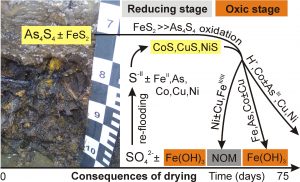 We combined selective chemical extractions and S isotopes to examine the mobility of As and trace metals (Co, Cu, Ni) in two Czech wetland soils enriched in authigenic Fe-As sulfide minerals through the drying process. We found that As and trace metals released via oxidation of the sulfide phases (particularly Fe sulfides) were almost entirely sequestered by Fe(III) (oxyhydr)oxides, but concomitant acidification resulted in the pH-dependent release of the As(III) and trace metals. Although our results documented the relatively low As mobilization potential under relatively short droughts (several weeks), the preservation of the anoxic conditions must be regarded as a fundamental management strategy of these and other sulfidic wetlands enriched in As.
We combined selective chemical extractions and S isotopes to examine the mobility of As and trace metals (Co, Cu, Ni) in two Czech wetland soils enriched in authigenic Fe-As sulfide minerals through the drying process. We found that As and trace metals released via oxidation of the sulfide phases (particularly Fe sulfides) were almost entirely sequestered by Fe(III) (oxyhydr)oxides, but concomitant acidification resulted in the pH-dependent release of the As(III) and trace metals. Although our results documented the relatively low As mobilization potential under relatively short droughts (several weeks), the preservation of the anoxic conditions must be regarded as a fundamental management strategy of these and other sulfidic wetlands enriched in As.
Drahota P., Peřestá M., Trubač J., Mihaljevič M., Vaněk A. (2021): Arsenic fractionation and mobility in sulfidic wetland soils during experimental drying. Chemosphere 277, 130306. (DOI)
Successful virtual PhD conference

We had a successful virtual conference, which has been jointly organized by PhD students associated to the Center for Geosphere Dynamics (UNCE/SCI/006 project) and SGA Student Chapter Prague. The morning of 15th April 2021 was full of exciting presentations (see program and abstracts here). Thanks go to all participants (we were up to 45), but especially to Rafael Baieta, Marine Jouvent and Marek Tuhý, who organized the conference and chaired individual sessions within the ZOOM platform!
Marek Tuhý spoke about diamonds in the Czech TV channel for kids
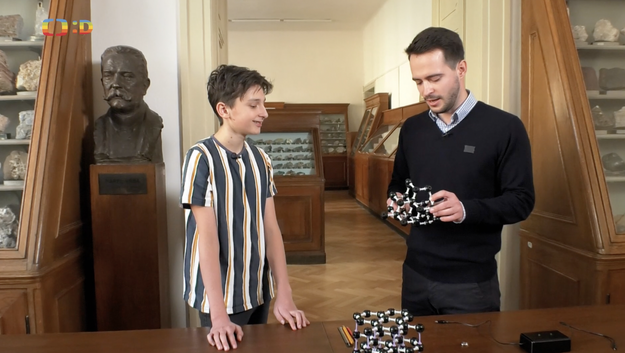 Marek Tuhý, a PhD student associated to the Center, spoke about diamonds in the Czech TV channel for kids (CT D:-)) in a TV show called “Wifina”. This part of the broadcast was published on March 31, 2021 and is available in the Czech TV online archive.
Marek Tuhý, a PhD student associated to the Center, spoke about diamonds in the Czech TV channel for kids (CT D:-)) in a TV show called “Wifina”. This part of the broadcast was published on March 31, 2021 and is available in the Czech TV online archive.
